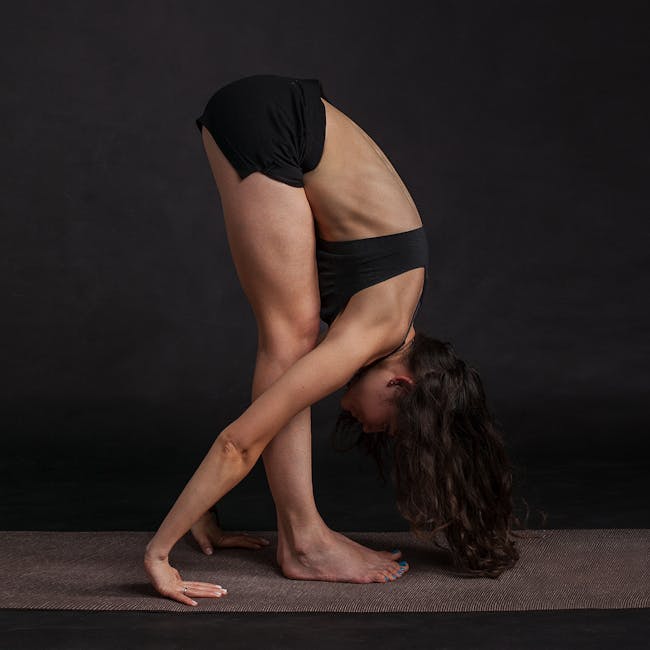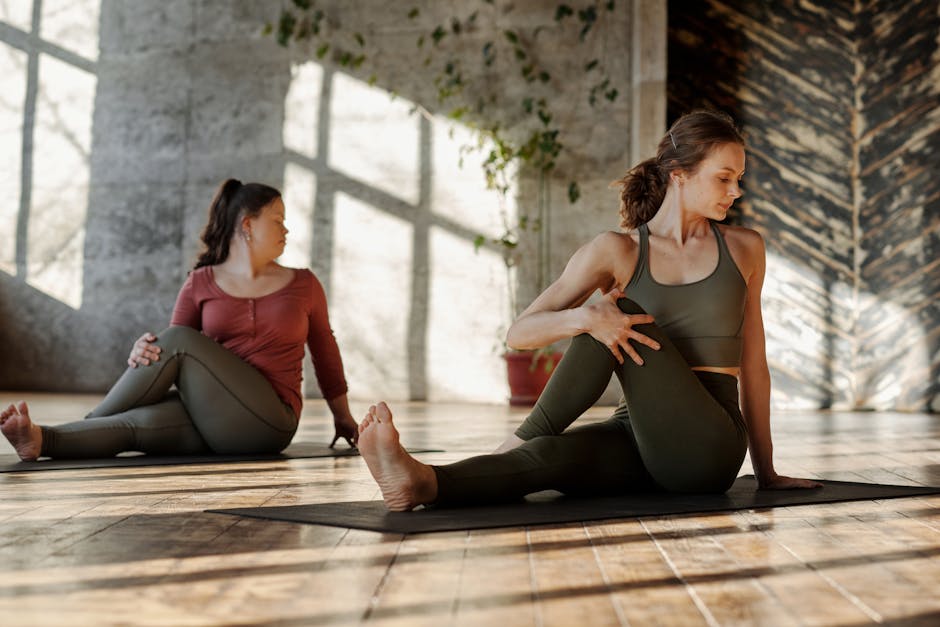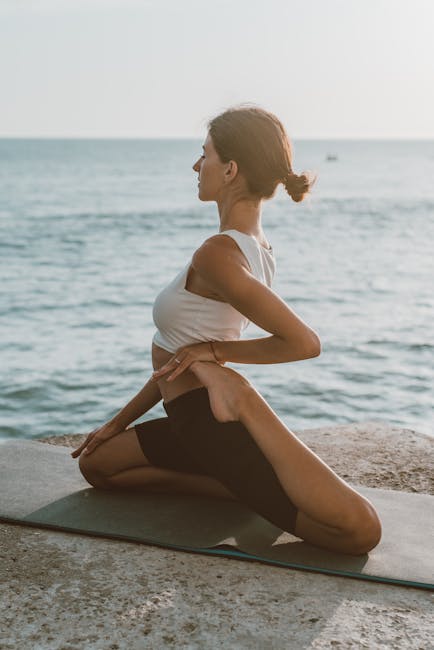Yoga, an ancient practice rooted in over 5,000 years of Indian philosophy, has become a beacon of hope for those seeking solace in the chaos of modern life. Its benefits are manifold, but particularly notable is its ability to enhance flexibility and alleviate muscle stiffness, offering a natural and holistic approach to physical well-being.
Key Takeaways
- Yoga improves flexibility by gently stretching and lengthening the muscles.
- Regular yoga practice can significantly reduce muscle stiffness and increase range of motion.
- Specific yoga poses target different areas of the body, promoting overall physical health.
- Practicing yoga safely is crucial to prevent injury and maximize the benefits of each pose.
- Integrating yoga into one’s daily routine can lead to long-term improvements in flexibility and muscle health.
Introduction to Yoga and Flexibility
Definition of Yoga
Yoga is a comprehensive system for well-being on all levels: physical, mental, emotional, and spiritual. While many view it primarily as physical exercise, it is also a meditative and spiritual practice.
Connection between Yoga and Flexibility
The connection between yoga and flexibility is undeniable. Yoga poses, known as asanas, are designed to stretch various muscle groups, enhance joint mobility, and promote suppleness in the body.
Overview of Muscle Stiffness
Muscle stiffness often occurs due to prolonged inactivity, repetitive motions, or aging. It can limit movement and cause discomfort, which yoga can help alleviate.

Benefits of Yoga for Flexibility and Muscle Stiffness
Stretching and Toning Muscles
Yoga’s gentle stretching exercises encourage muscles to elongate, which can lead to improved muscle tone and flexibility over time.
Enhancing Overall Flexibility
Through consistent practice, yoga can enhance one’s overall flexibility, making daily activities easier and reducing the risk of injury.
Reducing Muscle Stiffness
Yoga increases blood flow to stiff muscles, helping to reduce stiffness and promote relaxation.
Improving Strength and Balance
In addition to flexibility, yoga poses build strength and improve balance, contributing to a well-rounded fitness regimen.

Yoga Poses for Improved Flexibility
Back Flexibility
Intense Side Stretch (Parsvottanasana)
This pose stretches the spine, shoulders, and hamstrings, promoting flexibility in the back.
Head to Knee (Janu Sirsasana)
Janu Sirsasana calms the mind while deeply stretching the back and legs.
Core Flexibility
Cat-Cow (Bitilasana Marjaryasana)
The fluid movement between these two poses warms the body and brings flexibility to the spine.
Bow Pose (Dhanurasana)
Dhanurasana challenges the core muscles while opening up the chest and shoulders.
Hip Flexibility
Low Lunge (Anjaneyasana)
This pose helps release tension in the hips, promoting flexibility and ease of movement.
Wide-Angle Seated Forward Bend (Upavistha Konasana)
A deep stretch for the insides of the thighs, this pose also encourages flexibility in the hips and spine.
Shoulder and Neck Flexibility
Cow Face Pose (Gomukhasana)
Gomukhasana stretches the shoulders, armpits, triceps, and chest, enhancing flexibility in the upper body.
Plow Pose (Halasana)
This inversion stretches the shoulders and spine while also calming the nervous system.

Targeting Different Body Areas for Flexibility
Back
Yoga poses like the Cobra (Bhujangasana) and the Bridge (Setu Bandhasana) target the back, strengthening and increasing its flexibility.
Core
Poses such as the Plank (Kumbhakasana) and the Boat (Navasana) focus on the core, which is essential for a strong, flexible body.
Hips
The Pigeon Pose (Kapotasana) and the Frog Pose (Mandukasana) are excellent for opening up the hips and increasing flexibility.
Shoulders and Neck
Shoulder stands (Sarvangasana) and the Eagle Pose (Garudasana) are great for relieving tension and improving flexibility in the shoulders and neck.

Safety Tips for Practicing Yoga
Preventing Injury
To prevent injury, always warm up before practicing and listen to your body’s limits.
Maximizing Benefits of Poses
Proper alignment and breathing techniques are key to maximizing the benefits of each yoga pose.
Considerations for Pre-existing Conditions
Individuals with pre-existing conditions should consult with a healthcare provider before beginning a yoga practice.

The Impact of Regular Yoga Practice
Maintaining Physical Health
Regular yoga practice contributes to maintaining physical health and can prevent the onset of flexibility issues.
Enhancing Range of Motion
Yoga can significantly enhance one’s range of motion, making it easier to perform both simple and complex movements.
Long-term Benefits for Flexibility and Stiffness
Over time, yoga can lead to lasting improvements in flexibility and a reduction in muscle stiffness.
Yoga as a Holistic Approach to Health
Physical Benefits
Yoga offers a plethora of physical benefits, including improved flexibility, strength, and balance.
Mental and Emotional Benefits
The practice also supports mental and emotional health, reducing stress and promoting relaxation.
Integrating Yoga into Daily Routine
Incorporating yoga into one’s daily routine can lead to a more balanced and healthy lifestyle.

Conclusion
Summary of Yoga’s Role in Flexibility
Yoga plays a significant role in improving flexibility and reducing muscle stiffness, offering a natural approach to maintaining physical health.
Encouragement to Incorporate Yoga
Individuals are encouraged to incorporate yoga into their lives to experience its full range of benefits.
Final Thoughts on Yoga for Muscle Stiffness
With its ability to target various body areas and promote overall well-being, yoga stands as an effective remedy for muscle stiffness and a path to greater flexibility.
Incorporating yoga into one’s fitness routine can be a transformative experience. For those looking to delve deeper into the practice, exploring yoga for flexibility can provide a solid foundation. Athletes may find tailored benefits by examining yoga for athletes, while a comprehensive understanding of various yoga poses can enhance one’s practice. For those seeking a more meditative approach, yoga as meditation offers a path to inner peace. Lastly, understanding the nuances of Hatha yoga can enrich one’s knowledge of this ancient discipline.
By embracing yoga, individuals can embark on a journey toward a more flexible, vibrant, and harmonious life.
Unraveling the Stretch: Your Yoga Flexibility & Muscle Relief FAQ Guide
What makes yoga effective in improving flexibility?
Yoga is effective in improving flexibility because it involves a variety of postures and stretches that target different muscle groups. The practice encourages slow, controlled movements coupled with deep breathing, which helps to warm up the muscles and make them more pliable. Over time, regular yoga practice can increase the range of motion in joints, lengthen muscles, and reduce tightness throughout the body.
Can yoga help with muscle stiffness, and if so, how?
Yes, yoga can help with muscle stiffness. The gentle stretching and holding of yoga poses promote blood circulation to the muscles, which can help to flush out toxins and deliver nutrients needed for repair. This increased blood flow can help to alleviate stiffness and promote faster muscle recovery. Additionally, yoga’s emphasis on mindfulness and relaxation can reduce the tension that often contributes to stiff muscles.
Is yoga suitable for beginners looking to improve flexibility?
Absolutely, yoga is suitable for beginners. There are various levels of yoga, and many poses have modifications to accommodate different flexibility levels. Beginners can start with basic stretches and gradually progress to more advanced poses as their flexibility improves. It’s important to listen to your body and not push into painful ranges of motion.
How often should I practice yoga to see improvements in flexibility?
Consistency is key when it comes to improving flexibility with yoga. Practicing yoga 2-3 times a week can lead to noticeable improvements. However, even a short daily practice can be beneficial. It’s less about the duration of each session and more about the regularity. Over time, with consistent practice, you’ll likely see an increase in flexibility.
What are some specific yoga poses known for improving flexibility?
Several yoga poses are particularly effective for improving flexibility. For example, ‘Downward-Facing Dog’ stretches the hamstrings and calves, ‘Cobra Pose’ increases flexibility in the spine and chest, ‘Child’s Pose’ gently stretches the hips, thighs, and ankles, and ‘Seated Forward Bend’ can help lengthen the hamstrings and spine.
Can yoga alone be enough to relieve muscle stiffness, or should it be combined with other activities?
Yoga can be a comprehensive approach to relieving muscle stiffness, but it can also complement other activities. Incorporating yoga into a broader fitness routine that includes cardiovascular exercise, strength training, and other forms of stretching can provide a well-rounded approach to muscle health and flexibility.
Are there any risks of injury when using yoga to improve flexibility?
While yoga is generally safe, there is a risk of injury if poses are performed incorrectly or without proper guidance, especially for those new to the practice. It’s important to start with a qualified instructor who can ensure you’re performing poses correctly and not pushing your body beyond its limits. Always listen to your body and avoid forcing yourself into painful positions.
Do I need any special equipment to start practicing yoga for flexibility?
No special equipment is necessary to start practicing yoga. However, a yoga mat can provide cushioning and prevent slipping. Props like yoga blocks and straps can also be helpful, especially for beginners, as they provide support and help with alignment in certain poses. These tools can make yoga more accessible and comfortable, particularly when working on flexibility.
How does breath work in yoga affect muscle stiffness and flexibility?
Breath work, or pranayama, is a crucial aspect of yoga that can significantly affect muscle stiffness and flexibility. Deep, mindful breathing helps to relax the body and mind, which can reduce tension in the muscles. Breathing techniques also help to oxygenate the blood, which improves circulation and can aid in the release of tight muscles and the enhancement of flexibility.
Can yoga improve flexibility in all age groups?
Yes, yoga can improve flexibility across all age groups. While flexibility naturally decreases with age, yoga can help to slow this process and maintain mobility. It’s a low-impact form of exercise that can be modified to suit any fitness level and is particularly beneficial for maintaining joint health and muscle elasticity as we age.



